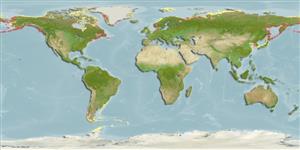Common names from other countries
Classification / Names / Names
Common names | Synonyms | Catalog of Fishes (gen., sp.) | ITIS | CoL | WoRMS
Environment: milieu / climate zone / depth range / distribution range
Ecology
Sessile; depth range 30 - 100 m (Ref. 116516). Temperate
Northern Atlantic, Northern Pacific and the Arctic: Alaska, Canadian Arctic Archipelago, and Europe. Temperate to polar climates.
Length at first maturity / Size / Weight / Age
Maturity: Lm ? range ? - ? cm Max length : 8.0 cm BL male/unsexed; (Ref. 7726)
Known from subtidal to deep water on hard substrates; encrusted with marine plants and bryozoans. Thrives in current and surge swept areas (Ref. 7726).
Life cycle and mating behavior
Maturity | Reproduction | Spawning | Eggs | Fecundity | Larvae
Members of the class Ascidiacea are hermaphroditic; both cross- and self-fertilization is typical. Life cycle: Eggs develop into lecithotrophic larva before metamorphosing into benthic adults.
Hansson, H.G. 1989. (Ref. 3399)
IUCN Red List Status (Ref. 130435)
CITES status (Ref. 108899)
Not Evaluated
Not Evaluated
Human uses
| FishSource |
Tools
More information
Age/SizeGrowthLength-weightLength-lengthMorphologyLarvaeAbundance
Internet sources
Estimates based on models
Preferred temperature
(Ref.
115969): 0.5 - 10.3, mean 3.5 (based on 1095 cells).
Vulnerability
Low vulnerability (10 of 100).
Price category
Unknown.
